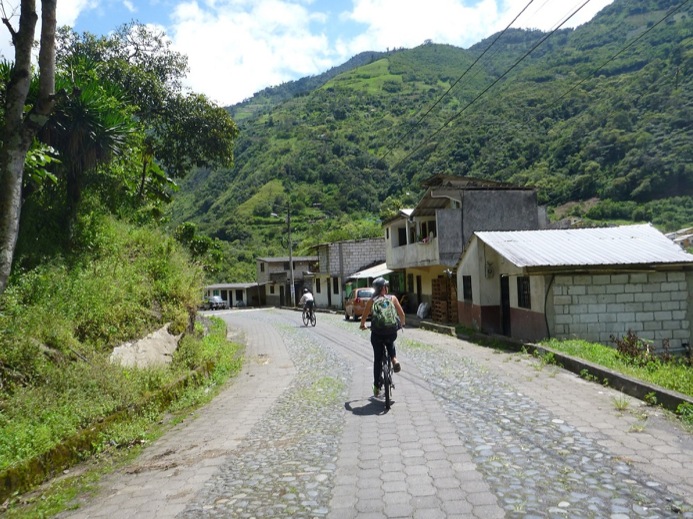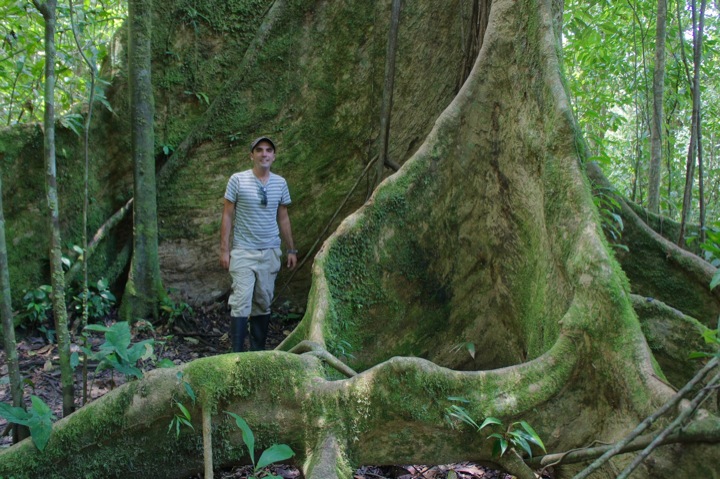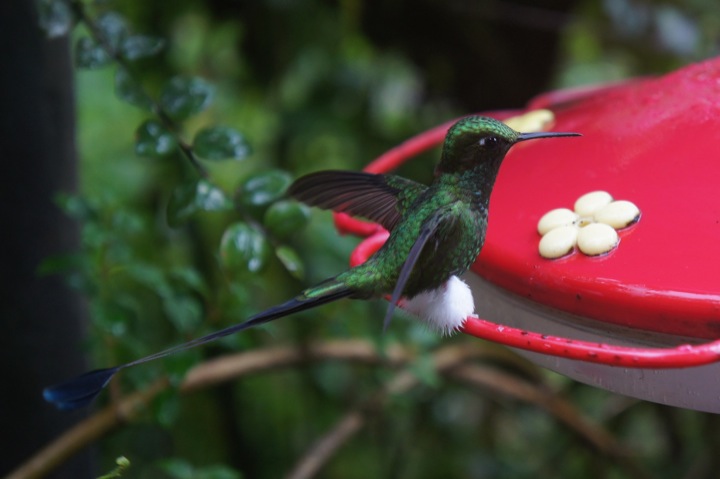Our first day in Latacunga we awoke and ate a lovely breakfast in the hostel courtyard before being picked up by our guide (along with a really weird Dutch guy) for a trip to the south face of Volcan Cotopaxi. The trip started with a 2 hour drive to a refuge at 3,500m with spectacular views over the valley. From there we hiked for about an hour and a half to 4,800m alongside a canyon carved by the lava from previous eruptions. The volcano has destroyed Latacunga 3 times over the years and as a result, the town that was initially founded at an altitude of 800m is now at 2,700m. The walk wasn’t as strenuous as the walk in Quilitoa and we made it to the ridge with no difficulties. We didn’t attempt the climb to the top at 5,943m as it’s not the right season for visibility. The higher you climb the more sparse the vegetation and the ground is covered with ash that clogs together to look like a kind of spongy land coral. At the ridge we could see down into the valley with the rocks all different colours depending on whether they were formed from lava, ash or foam. The stupid Dutch guy decided to go his own little way and we started heading back down to the refuge without him for lunch just as a storm was coming in. The Dutch guy turned up half an hour later while we were enjoying our pack lunch and just as we finished eating an andean condor came gliding past the window. We felt pretty lucky since there are only 67 left in Ecuador and only 4 in Cotopaxi National Park and they are pretty impressive with wingspans of up to 3.2m. After lunch we drove back in to Latacunga and spent the evening relaxing before heading out to a cheap café for dinner.
The next day we headed to Banos after breakfast. Although there are no direct buses from the bus station our hostel had told us of a direct bus from the outskirts of town so we jumped in a cab to the San Felipe bridge and straight onto a waiting bus. 2 hours later we were in Banos and checked in to a cheap hotel south of town. We popped out for tapas at a lovely café with an outdoor patio area and had a wonder around town before heading back to the hotel. The town is one of the most popular tourist destinations in Ecuador and has a certain charm to it set amongst mountains with sweet stalls lining the streets with people stretching sugar to make melcocha, a kind of softer version of a stick of rock. That night we ate in the plaza overlooking the black volcanic stone cathedral at a booth selling hamburgers. Next we headed to the tour agency where we had booked a chiva trip up to a mirador where we hoped to be able to see lava exploding from Volcan Tungurahua. The trip was awful. The chiva, one of the open sided truck things with rows of seats on had been decked out with flashing neon lights and played regatone at full volume all the way up to the viewpoint. We then had to stand around for over an hour twiddling our thumbs waiting for the return trip into town with not so much as a puff of smoke visible from the volcano, anyone reading this and going to Banos, avoid the trip at all costs.
On our first full day in Banos we ate breakfast on the hotel roof terrace overlooking one of the waterfalls in town then we headed out to rent bikes to ride the first 20 km of the Banos to Puyo road following the Pastaza valley along the newly christened Ruta De Las Cascadas. There are over a dozen waterfalls on the route and the first 20 kms took us to about 7 of them. We started slowly with mum getting to grips with a bike with gears and missed the first waterfall. At the second one though we saw a sign for a tarabita (cable car) and chained up our bikes so we could take the ride over the valley to follow a trail to the top of a waterfall. A little further along the road after 18km and we came to the most impressive waterfall of the day, the El Pailón del Diablo (Devil’s Cauldron). There are numerous viewing platforms and suspension bridges so you can see the falls from all angles and then after crossing the bridge on the main road you can enter again from the other side and crawl through a narrow passage to pass behind the falls. The last stop of the day was Machay waterfalls by which point all the cycling and walking up and down the hillside had worn us out too much to walk further than the first viewing platform. We headed back to the main road and to the bus stop to try to work out how to get a lift back in to town (the route is pretty much all down hill out of Banos so all uphill to go home and we had no intention of cycling it). After 30 mins of trying to flag anything that looked plausible as a lift and as the rain started an official truck pulled up and loaded our bikes into the back. We returned the bikes and headed to the hotel to rest.
That night we met up with Monique and headed to the thermal springs – it was like a dirty outdoor swimming pool with one pool at 45 degrees too hot to stay in for more than a minute without scorching yourself, it was truly painful. Afterwards we headed to an international restaurant for dinner and on to a bar in town for cocktails it being Friday night. One screwdriver later and I walked mum back to the hotel before heading back out to meet Monique and Rhys. We watched some of Monique’s friends salsa, sat by a firepit in an Irish bar and were home in bed a little after 2am.
The next day me and mum went for a walk around town to buy some sweets for her to take into work when she got back while Rhys sat in the hotel watching TV. At 3pm Rhys joined me for a steam bath in the hotel spa, mum was too sun burnt from Quilatoa to have one. It started by sitting in a big wooden box with just our heads poking out while they pumped in steam, then after a couple of minutes you were let out and had to brush your body with a cold flannel before starting the process all over again, after the third time you had to sit in a bucket seat full of cold water and then after the last time in the steam box you had to stand there while the woman jet washed you with ice cold water. Rhys wasn’t too keen on it but it was quite enjoyable – and would probably have been more so if we weren’t a little hung over. Rhys went back to the room to play on the computer and at 5pm I had a chocolate massage booked; a full body massage where you get coated in chocolate along with reflexology, a head massage, aromatherapy and hot compresses. It was all fun and games until I woke up in the night with the worst pain where she’d been way to rough with me, I think she managed to pull a neck muscle or something, it’s taken days to recover and Rhys has had to help out with my bag, he’s banned me from massages now. That night we went to a BBQ restaurant for dinner.
We caught a bus out of Banos for Tena at 10:40am the next day. The bus was packed and we didn’t end up with seats together, I had to sit with some woman half on my chair and her baby flopping about. We got to Tena quicker than expected though in 3 hours and took a taxi to a hostel we’d read about. We dumped our bags and went for a walk around town to try to book a jungle trip for the next day with absolutely no luck – everywhere apart from our hostel was closed as it was Sunday and the trip from our hostel just wasn’t what we had in mind. After some consideration we decided the best idea was to get in a cab to nearby Misahualli and to either do day trips from there or try to organise something once we were there. It was so much nicer than Tena, just a small place located on the Napo River with Capuchin monkeys running around the plaza terrorising the local dogs. Although the hotel was a little over budget the cabins were set in beautiful tropical gardens with a lovely pool and a mirador with a fire pit and the best dog ever. We spoke to a couple of tour operators and arranged a trip through a French/Ecuadorian agency who also arrange volunteer placements with a local Kichwa community. We were relieved to have a trip booked and to have left Tena. We grabbed some street food, chicken skewers and empanadas for dinner and headed back to enjoy the fire at the hostel with a carton of cheap red wine.
Early the next day we were up enjoying an amazing breakfast of croissants, eggs and all kinds of tropical jams before heading to the tour agency to meet our Kichwa guide and our Ecuadorian/American translator. The trip started with a motorised canoe ride (with a roof for shade thankfully), to a riverside museum where a local guy took us around to show us different traps used by local people that they’d mocked up in a bit of forest, the tour ended with us trying out a blow pipe, I have to say none of us would be eating if it was down to our blow pipe skills. After that we were back in the canoe for the trip to AmaZoonico. A wildlife refuge set up in the jungle on an island in the river Napo for Amazonia animals, founded by a Swiss group and run by volunteers. It was really interesting to see and sad to hear some of the animals stories. We had a tour of the animals who couldn’t be released from cages for their own good before walking for 2 hours through the rainforested ‘liberation zone’ where numerous animals had been released – although we didn’t spot any animals other than a woolly monkey we did chew a couple of lemon ants each. Back in the canoe our next stop was at a ceramic workshop, it was brief and after watching a girl make a pretty rubbish looking pot we were back in the canoe again and headed for our cabin.
The cabins we stayed at were very new, the rooms were huge with ensuites and hot water, far superior to the dorms we stayed at in Rurrenabaque. We showered, had a beer sitting on a bench overlooking the river and the forest and ate dinner in the communal shelter before heading out on a night walk through the forest close to the cabins. Although we heard an armadillo we only saw insects, lots of spiders, stick insects, crickets, centipedes and hundreds of moths.
Once we were tucked up in bed a massive storm hit. It went on all night and the noise of the torrential rain on our corrugated iron roof and the thunder was deafening. We had arranged to go on a 6 hour hike early the following morning but had to put it off due to the storm that was still raging. We relaxed at the cabins and caught up on some sleep until noon when the rain started to subside and pulling on our wellies we started the hike. We spent 3 hours walking to a waterfall through both primary and secondary forest with our guide stopping every now and then to explain the medicinal properties of the trees and plants and giving us various things to taste. By the time we got to the waterfalls we had tribal drawings with natural ink on our faces and I had a lovely handbag made out of leaves and vines. The water at the river was high because of the storm so we couldn’t get too close to the waterfall and had to wade across some fast flowing water. The walk back only took a couple of hours and we spent a second night at the cabins in the forest before heading back to Misahualli the following morning. The jungle trip wasn’t quite what we’d expected, there were hardly any animals or birds to be seen, just lots of bugs and butterflies including lots of conga ants that are about an inch long and can give you a bite that would put you in bed for days. It was really interesting though to see how people live with the jungle, learning about traditional uses for plants, speaking to a local family who have a plantation in the jungle and who have had all their chickens eaten by a puma and watching people just carrying out daily chores along the river banks. It wasn’t a wildlife experience but was very educational and you can’t help but be mesmerised by the 45m tall, 700 year old trees and the vegetation in all shades of green you could ever imagine.
 |
| Mum hiking Cotopaxi Volcano. |
 |
| Me and Rhys, Cotopaxi Volcano. |
 |
| Bike ride, Banos. |
 |
| Rhys at El Pailón del Diablo waterfall. |
 |
| Steam baths, Banos. |
 |
| Capuchin monkey, Misahualli main square. |
 |
| Rhys and a MASSIVE tree in the jungle. |
 |
| Our cabin in the jungle. |
 |
| Poisonous frog. |
 |
| Cricket on cacao left out to dry. |






























